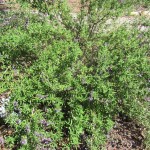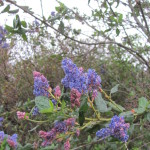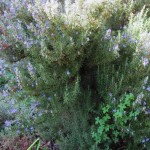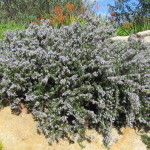When I got home last night in the rain, I took in the air in deep breaths: Such a wonderful smell of wet soil and decaying leaves mixed with something sweet and flowery – where was this powerful scent coming from? So I put on my boots, took a flash light and went into the garden.
 I got my face wet as I poked my nose into foliage and flowers of shrubs, perennials and succulents, and not far from my front door I found the first: A grouping of Cleveland Sages Salvia clevelandii that had just opened their buds. These California natives are known for their incredible fragrance, and for those who have never seen or smelled any, the description alone should make your mouth water: This is an evergreen shrub of the mint family with a refined, rounded and arching form, to 3 to 5 ft tall and wide and wider for some cultivars. It has wrinkled, toothed gray-green or dark green leaves that can be used in teas or as substitute for culinary sage and that are deliciously fragrant; a breeze blowing through your garden will take the sweet fragrance far. The flowers are an inch-long, pale lavender or violet-blue, arranged in whorls along the stems, and they are also fragrant. To encourage re-bloom you will need to cut back these flower spikes back, but the shrub is also attractive with its dried flower spikes.
I got my face wet as I poked my nose into foliage and flowers of shrubs, perennials and succulents, and not far from my front door I found the first: A grouping of Cleveland Sages Salvia clevelandii that had just opened their buds. These California natives are known for their incredible fragrance, and for those who have never seen or smelled any, the description alone should make your mouth water: This is an evergreen shrub of the mint family with a refined, rounded and arching form, to 3 to 5 ft tall and wide and wider for some cultivars. It has wrinkled, toothed gray-green or dark green leaves that can be used in teas or as substitute for culinary sage and that are deliciously fragrant; a breeze blowing through your garden will take the sweet fragrance far. The flowers are an inch-long, pale lavender or violet-blue, arranged in whorls along the stems, and they are also fragrant. To encourage re-bloom you will need to cut back these flower spikes back, but the shrub is also attractive with its dried flower spikes.
This plant is so popular that several hybrids have been created: Mine is the ‘Allen Chickering’ which gets to 4 ft tall but spreads out to about 6 ft and sports pale purple flowers. Check out also ‘Winifred Gilman’ with lavender-blue-purple flowers, or ‘Aromas’ with gray-green foliage and deep lavender flowers, ’Pozo Blue’ that is hardier than Alan Chickering’ (to 10 degrees F). 
The Cleveland sages need sun (partial sun only in the hottest, driest regions), fast-draining soil, and are drought tolerant although they can tolerate occasional watering. There are differences in their cold tolerances that could be important for your location; please check with the growers below for the appropriate one.
A little deeper in my garden the beam of my flashlight hit a tall lanky shrub whose buds were just opening, and I know it carries its name Mountain Lilac for a good reason: The flowers look like miniature Lilac clusters, and to me even their smell reminds me of true Lilac. Mine is the hybrid ‘Ray Hartman’ which is the best known and most commonly grown of the bigger ceanothus hybrids that can reach 18 feet in height and width; its rose-colored buds open to display profuse clusters of sky blue flowers. 
California’s Mediterranean climate supports 60 species and varieties of ceanothus, and the choices can be confusing. They grow in some of California’s harshest habitats, ranging from wind-buffeted coastal headlands to dry, exposed slopes at the edge of the Mojave Desert. They come in various forms, from creeping to large shrubs and small trees, and their colors range from bluish whites and pale purples to deep Gentian blue and purple. Most grow in areas that experience an extended summer drought; they tolerate a range of soil types but often are located on steep slopes in well-drained soils of low or marginal fertility. Most then require excellent drainage, but some can also tolerate heavy soil and summer water.
Ceanothus have become popular shrubs in Europe, where cultivation of ceanothus species for horticultural purposes began as early as 1713! Check with one of the growers mentioned below for the species that will perform best in your garden so that its growing conditions match or approach those found in its provenance.
Not far from my backdoor (and closer to the kitchen) I found Rosemary, a true Mediterranean whose name means “dew of the sea”, reminding us of the plant’s native habitat on seaside cliffs in the Mediterranean region. This winter bloomer is not quite as fragrant as my sages but also definitely desirable. The evergreen shrub is covered with narrow, resinous dark green leaves, and through winter and spring its fragrant pale blue to deep violet flowers are a magnet for bees and small birds looking for tiny spiders and insects in the tightly packed flowers (and perhaps also eat the petals).
 I love the ‘official’ Rosemary (Rosmarinus officinalis) with its upright habit and somewhat twisted branches reaching for the sky (height typically 4-6 ft and more, especially ‘Blue Spires’). I use its stems for bouquets and the leaves for cooking; even the fragrant flowers are edible.
I love the ‘official’ Rosemary (Rosmarinus officinalis) with its upright habit and somewhat twisted branches reaching for the sky (height typically 4-6 ft and more, especially ‘Blue Spires’). I use its stems for bouquets and the leaves for cooking; even the fragrant flowers are edible.
As with many popular plants, there are too many cultivars and hybrids available to mention here. Of great importance are the prostrate ground-hugging kinds whose heights range from 1 ft to 6 ft or more that are often used in erosion control or as groundcovers. 
The toughness of Rosemary is admirable: It’s tolerant of moderate watering, sea-side conditions and blistering sun; I think it’s a must-have in the Mediterranean garden. Although it can take alkaline soil if given a moderate feeding from time to time, good drainage is essential; you can lighten heavy soil with plenty of organic matter. Their cold-hardiness varies depending on selection.
All of these specimens are excellent examples of low water-use, low maintenance, beneficial plants that I love to use in water-wise landscape designs; I think they belong to the category of plants that are indispensible when the design wants to be ‘sustainable’, and with these attributes and their famous fragrance who could resist?
For California natives plants in San Diego County, check out these growers:
Las Pilitas Nursery, in Escondido, at http://www.laspilitas.com/
Moosa Creek Nursery, in Valley Center, at http://www.moosacreeknursery.com/
Recon Environmental Inc., in San Diego, at http://www.recon-us.com/